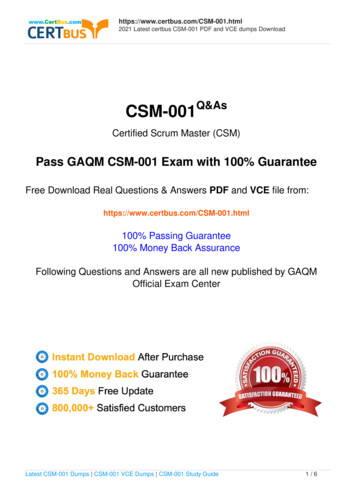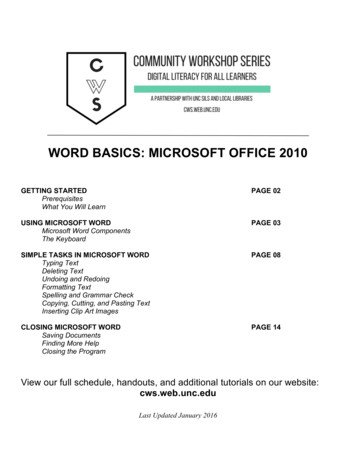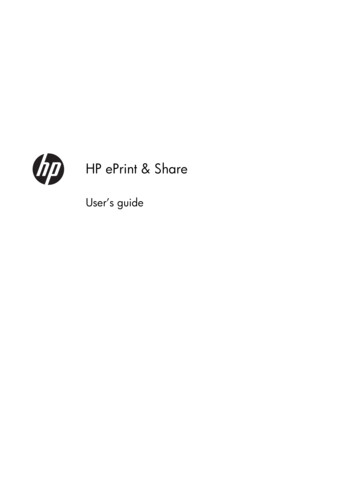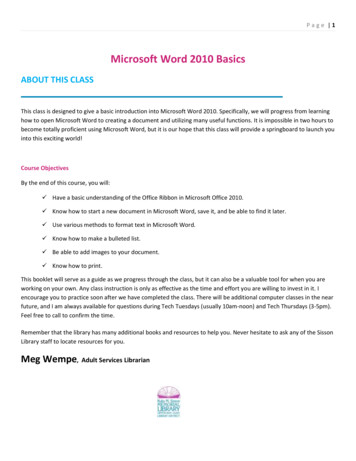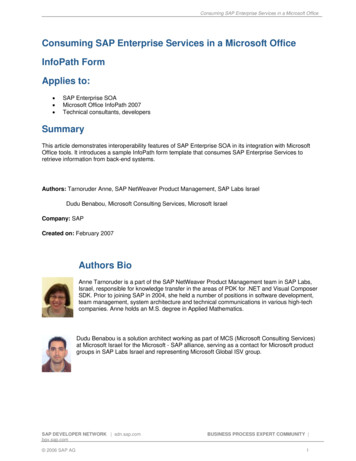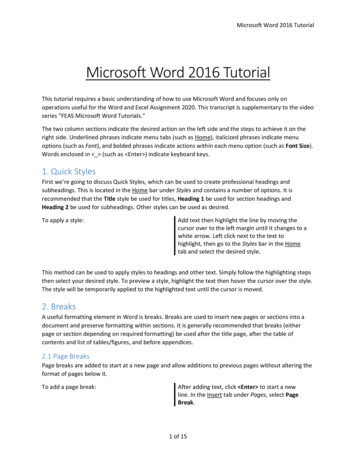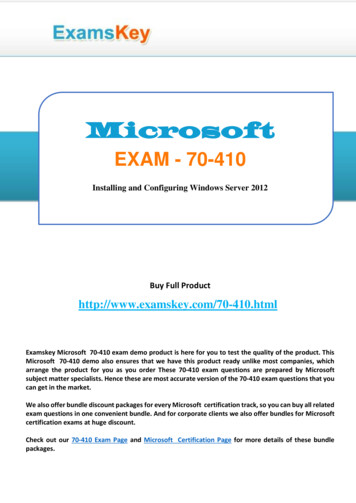
Transcription
MicrosoftEXAM - 70-410Installing and Configuring Windows Server 2012Buy Full Producthttp://www.examskey.com/70-410.htmlExamskey Microsoft 70-410 exam demo product is here for you to test the quality of the product. ThisMicrosoft 70-410 demo also ensures that we have this product ready unlike most companies, whicharrange the product for you as you order These 70-410 exam questions are prepared by Microsoftsubject matter specialists. Hence these are most accurate version of the 70-410 exam questions that youcan get in the market.We also offer bundle discount packages for every Microsoft certification track, so you can buy all relatedexam questions in one convenient bundle. And for corporate clients we also offer bundles for Microsoftcertification exams at huge discount.Check out our 70-410 Exam Page and Microsoft Certification Page for more details of these bundlepackages.
Question: 1You have a server named Server1 that runs Windows Server 2012 R2. Server1 has the Hyper-V serverrole installed.An iSCSI SAN is available on the network.Server1 hosts four virtual machines named VM1, VM2, VM3, and VM4.You create a LUN on the SAN to host the virtual hard drive files for the virtual machines.You need to create a 3-TB virtual hard disk for VM1 on the LUN. The solution must prevent VM1 frombeing paused if the LUN runs out of disk space.Which type of virtual hard disk should you create on the LUN?A. Dynamically expanding VHDXB. Fixed-size VHDXC. Fixed-size VHDD. Dynamically expanding VHDAnswer: BExplanation:The virtual disk needs to be a VHDX file since it is going to be over 2TB in size and it must be fixed-sizeso that the space is already taken on the server (that way the server does not run out of space as thevolume grows) even if the actual virtual disk does not yet hold that amount of data.Question: 2Your network contains an Active Directory domain named adatum.com. The domain contains amember server named Host1. Host1 runs Windows Server 2012 R2 and has the Hyper-V server roleinstalled.Host1 hosts two virtual machines named VM5 and VM6. Both virtual machines connect to a virtualswitch named Virtual1.On VM5, you install a network monitoring application named Monitor1.You need to capture all of the inbound and outbound traffic to VM6 by using Monitor1.Which two commands should you run from Windows PowerShell? (Each correct answer presents partof the solution. Choose two.)A. Get-VM “VM6″ Set-VMNetworkAdapter-IovWeight 1B. Get-VM “VM5″ I Set-VMNetworkAdapter -IovWeight 0C. Get-VM “VM5″ Set-VMNetworkAdapter -PortMirroring SourceD. Get-VM “VM6″ Set-VMNetworkAdapter -AllowTeaming OnE. Get-VM “VM6″ Set-VMNetworkAdapter -PortMirroring DestinationF. Get-VM “VM5″ Set-VMNetworkAdapter -AllowTeaming On2
Answer: C, EExplanation:-PortMirroring specifies the port mirroring mode for the network adapter. This can be set to None,Source, and Destination.If set to Source, a copy of every network packet it sends or receives is forwarded to a virtual networkadapter configured to receive the packets.If set to Destination, it receives copied packets from the source virtual network adapter.In this scenario, VM5 is the destination which must receive a copy of the network packets from VM6,which s the source.Reference: 7.aspxQuestion: 3You have a Hyper-V host named Server1 that runs Windows Server 2012 R2.Server1 has the virtualswitches listed in the following table.You create a virtual machine named VM1.VM1 has two network adapters. One network adapterconnects to vSwitch1. The other network adapter connects to vSwitch2.You configure NIC teaming onVM1.You need to ensure that if a physical NIC fails on Server1, VM1 remains connected to the network.What should you do on Server1?A. Run the Set-VmNetworkAdaptercmdlet.B. Add a new network adapter to VM1.C. Create a new virtual switch on Server 1.D. Modify the properties of vSwitch1 and vSwitch2.Answer: AQuestion: 4Your network contains two Hyper-V hosts that run Windows Server 2012 R2. The Hyper-V hostscontain several virtual machines that run Windows Server 2012 R2.3
You install the Network Load Balancing feature on the virtual machines.You need to configure the virtual machines to support Network Load Balancing (NLB).Which virtual machine settings should you configure?A. DHCP guardB. Port mirroringC. Router guardD. MAC addressAnswer: 9d11fcbb7ce/nlb-on-hyperv?forum winserverhypervFor NLB to be configured you need to enable MAC address spoofing.Question: 5You have a server named Server1 that runs Windows Server 2012 R2. Server1 has the Hyper-V serverrole installed. Server1 is connected to two Fibre Channel SANs and is configured as shown in thefollowing table.You have a virtual machine named VM1.You need to configure VM1 to connect to SAN1.What should you do first?A. Add one HBAB. Create a Virtual Fibre Channel SAN.C. Create a Hyper-V virtual switch.D. Configure network adapter teaming.Answer: BExplanation:You need your virtualized workloads to connect easily and reliably to your existing storage arrays.4
Windows Server 2012 provides Fibre Channel ports within the guest operating system, which allowsyou to connect to Fibre Channel directly from within virtual machines. This feature protects yourinvestments in Fibre Channel, enables you to virtualize workloads that use direct access to FibreChannel storage, allows you to cluster guest operating systems over Fibre Channel, and provides animportant new storage option for servers hosted in your virtualization infrastructure.With this Hyper-V virtual Fibre Channel feature, you can connect to Fibre Channel storage from withina virtual machine. This allows you to use your existing Fibre Channel investments to support virtualizedworkloads.Support for Fibre Channel in Hyper-V guests also includes support for many related features, such asvirtual SANs, live migration, and MPIO.Question: 6Your network contains an Active Directory domain named contoso.com. The domain contains a servernamed Server1. Server1 runs Windows Server 2012 R2 and has the Hyper-V server role installed.On Server1, you create and start a virtual machine named VM1. VM1 is configured as shown in thefollowing table.You need to recommend a solution to minimize the amount of disk space used for the checkpoint ofVM1.What should you do before you create the checkpoint?A. Run the Resize-VHD cmdlet.5
B. Convert Disk1.vhd to a dynamically expanding disk.C. Shut down VM1.D. Run the Convert-VHD cmdlet.Answer: CExplanation:Changing between a fixed and dynamic disk type does not alter the size of a SNAPSHOT much at all.However, since a snapshot is a record of a VMs state at the exact time that the snapshot was taken,shutting down the VM before taking the snapshot prevents the snapshot from having to contain all ofthe data in RAM (as there is no data in memory when a machine is powered down).The question states that the solution should minimize the amount of disk space used for thecheckpoint of VM1. If the checkpoint is taken while VM1 is running, there will be two attritional filespresent at the checkpoint location; a .VSV with VM1 saved state files and a .BIN file which containsVM1’s memory contents. If, however, VM1 is shut down first, these files will not be created, thussaving disk space.In order to convert Disk1.vhd to a dynamically expanding disk, VM1 still have to be shut down.Question: 7HOTSPOTYou have a Hyper-V host named Hyperv1 that runs Windows Server 2012 R2. Hyperv1 hosts a virtualmachine named Server1. Server1 uses a disk named Server1.vhdx that is stored locally on Hyperv1.You stop Server1, and then you move Server1.vhdx to an iSCSI target that is located on another server.You need to configure Server1 to meet the following requirements:Ensure that Server1 can start by using Server1.vhdx.Prevent Server1.vhdx from consuming more than 500 IOPS on the iSCSI target.Which two objects should you configure?To answer, select the appropriate two objects in the answer area.6
Answer:7
Question: 8You have a print server named Server1 that runs Windows Server 2012 R2.You discover that when there are many pending print jobs, the system drive occasionally runs out offree space.You add a new hard disk to Server1.You create a new NTFS volume.You need to prevent the print jobs from consuming disk space on the system volume.What should you modify?A. The properties on the new volumeB. The properties of the Print Spooler serviceC. The Print Server PropertiesD. The properties of each shared printerAnswer: CExplanation:Windows spools print jobs by default to the following directory as they are processed:8
%SystemRoot%\SYSTEM32\SPOOL\PRINTERS.It is possible for the administrator of a Windows print server to manually instruct Windows thelocation for placing the spool files, if for example there is a concern for disk space.Question: 9HOTSPOTA printer named Printer1 is configured as shown in the exhibit. (Click the Exhibit button.)To answer, complete each statement according to the information presented in the exhibit. Eachcorrect selection is worth one point.9
Answer:Explanation:* The printer is paused.* Jobs can always be permitted (even if the printer is paused, or printer not started).Note:StartTimeDate and time that a printer can start to print a job — if the printer is limited to print at specific times.This value is expressed as the time elapsed since 12:00 AM GMT (Greenwich Mean Time).This is sort of a trick question. As it stands, when the PowerShell script was executed, the printer is in"Paused" status, so any submitted job will go to the queue and remain there until the status is"Available". As for the ability to submit a job, a user can SUBMIT the job at any time. If it is outside ofthe printer's availability range, it will simply remain in the queue until the printer's start time isreached.Question: 10HOTSPOTYour network contains an Active Directory domain named contoso.com. The domain contains a printserver named Server1 that runs Windows Server 2012 R2.You share several printers on Server1.10
You need to ensure that you can view the printer objects associated to Server1 in Active DirectoryUsers and Computers.Which option should you select?To answer, select the appropriate option in the answer area.Answer:Explanation:You can view printer objects in Active Directory by clicking Users, Groups, and Computers ascontainers from the View menu in the Active Directory Users and Computers snap-in. By default,printer objects are created under the machine object in which they are shared. After you turn on theUsers, Groups, and Computers as containers option, you can see printers by expanding the printer'shost computer.11
Reference: http://supportHYPERLINK "http://support.microsoft.com/kb/235925# 35925# com/kb/235925# b/235925# blank"/kb/235925Question: 11HOTSPOTYou have a shared folder named Share1. The folder permissions of Share1 are configured as shown inthe Folder Permissions exhibit. (Click the Exhibit button.)The Share permissions of Share1 are configured as shown in the Share Permissions exhibit. (Click theExhibit button.)12
You have a group named Group1. The members of Group1 are shown in the Group1 exhibit. (Click theExhibit button.)13
Select Yes if the statement can be shown to be true based on the available information; otherwiseselect No. Each correct selection is worth one point.Answer:Explanation:NTFS permissions control access to the files and folders stored on disk volumes formatted with theNTFS file system. Share permissions control access to folders over a network. To access a file over anetwork, a user must have appropriate share permissions (and appropriate NTFS permissions if theshared folder is on an NTFS volume).Granting a user Full Control NTFS permission on a folder enablesthat user to take ownership of the folder unless the user is restricted in some other way.User1 wasnot granted Full Control permission.The Administrators have Full Control permission. I assume that User2 is an administrator since theGroup1 exhibit shows only User1 as a echnet.microsoft.com/enus/library/cc754178.aspx# /library/cc754178.aspx# com/enus/library/cc754178.aspx# nus/library/cc754178.aspx# net.microsoft.com/en-us/library/cc754178.aspx# s/library/cc754178.aspx# blank"aspx14
Exam Ref 70-410: Installing and configuring Windows Server 2012 R2, Chapter 2: Configure serverroles and features, Objective 2.1: Configure file and share access, p.75-80Question: 12Your network contains an Active Directory domain named adatum.com. The domain contains a servernamed Server1 that runs Windows Server 2012 R2.On a server named Core1, you perform a Server Core Installation of Windows Server 2012 R2. You joinCore1 to the adatum.com domain.You need to ensure that you can use Event Viewer on Server1 to view the event logs on Core1.What should you do on Core1?A. Run the Disable NetFirewallRule cmdlet.B. Install Remote Server Administration Tools (RSAT).C. Install Windows Management Framework.D. Run the Enable-Com Network Access Firewall Rule.Answer: DExplanation:Information regarding IPsec policy changes, etc. can be found in the Event Viewer. Thus you need toenable the NetFirewallRule command. This will allow you to view the event logs.Question: 13Your network contains two servers named Server1 and Server2 that run Windows Server 2012 R2.Server1 and Server2 are part of a workgroup.On Server1 and Server2, you create a local user account named Admin1.You add the account to thelocal Administrators group. On both servers, Admin1 has the same password.You log on to Server1 as Admin1. You open Computer Management and you.connect to Server2.When you attempt to create a scheduled task, view the event logs, and manage the shared folders,you receive Access Denied messages.You need to ensure that you can administer Server2 remotely from Server1 by using ComputerManagement.What should you configure on Server2?A. From Server Manager, modify the Remote Management setting.B. From Local Users and Groups, modify the membership of the Remote Management Users group.C. From Windows Firewall, modify the Windows Management Instrumentation (WMI) firewall rule.D. From Registry Editor, configure the LocalAccountTokenFilterPolicy registry value.15
Answer: DExplanation:The LocalAccountTokenFilterPolicy setting affects how administrator credentials are applied toremotely administer the computer.Reference: http://support.microsoft.com/kb/942817Question: 14HOTSPOTYou have a print server named Server1 that runs Windows Server 2012 R2.On Server1, you create and share a printer named Printer1.The Advanced settings of Printer1 are shown in the Advanced exhibit. (Click the Exhibit button.)The Security settings of Printer1 are shown in the Security exhibit. (Click the Exhibit button.)16
The Members settings of a group named Group1 are shown in the Group1 exhibit. (Click the Exhibitbutton.)17
Select Yes if the statement can be shown to be true based on the available information; otherwiseselect No. Each correct selection is worth one point.Answer:18
Question: 15Your network contains a server named Server1 that runs Windows Server 2012 R2.Server1 has theHyper-V server role installed.Server1 hosts four virtual machines named VM1, VM2, VM3, and VM4.Server1 is configured as shown in the following table.You install Windows Server 2012 R2 on VM2 by using Windows Deployment Services (WDS).You need to ensure that the next time VM2 restarts, you can connect to the WDS server by using PXE.Which virtual machine setting should you configure for VM2?A. NUMA topologyB. Resource controlC. resource meteringD. virtual Machine ChimneyE. The VLAN IDF. Processor CompatibilityG. The startup orderH. Automatic Start ActionI. Integration ServicesJ. Port mirroringK. Single-root I/O virtualization19
Answer: GExplanation:Configure the BIOS of the computer to enable PXE boot, and set the boot order so that it is bootingfrom the network is first.References: 0(v ws.10).aspxExam Ref 70-410, Installing and Configuring Windows Server 2012 R2, Chapter 3: Configure Hyper-V,Objective 3.1: Create and Configure virtual machine settings, p.144Training Guide: Installing and Configuring Windows Server 2012 R2: Chapter 7: Hyper-V Virtualization,Lesson 2: Deploying and configuring virtual machines, p.33520
THANKS FOR TRYING THE DEMO OF OUR PRODUCTVisit Our Site to Purchase the Full Set of Actual 70-410 Exam Questions With Answers.http://www.examskey.com/70-410.htmlWe Also Provide Practice Exam Software That Simulates Real Exam Environment And HasMany Self-Assessment Features. Download Free Product Demo From:http://www.examskey.com/70-410.htmlMoney Back GuaranteeCheck Out Our Customer Testimonialshttp://vimeo.com/10252121021
Microsoft 70-410 demo also ensures that we have this product ready unlike most companies, which arrange the product for you as you order These 70-410 exam questions are prepared by Microsoft subject matter specialists. Hence these are most accurate version of the 70-41
